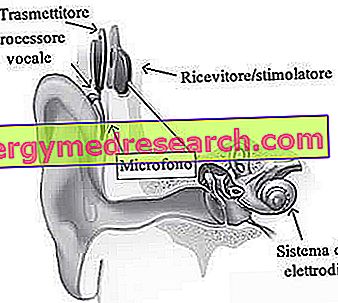Generality
A cochlear implant is a small, technologically very complex electronic device that allows deaf or people with reduced hearing ability to hear sounds again.

A generic cochlear implant includes external components, to be applied behind the ear, and internal components, to be inserted in the subcutaneous and close to the cochlea.
The installation of a cochlear implant requires the intervention of the surgeon. The most commonly used surgical procedure for inserting a cochlear implant is mastoidectomy.
Available for both adults and children, today's cochlear implants represent a very effective audiological support, not only in the presence of medium-severe hearing loss, but also in the presence of deafness.
Short revision of the inner ear and the cochlea
The inner ear essentially comprises two hollow structures: the cochlea, which is the organ of hearing, and the vestibular system (or vestibular apparatus), which is the organ of balance.
Each of these organs is connected to the brain by means of a nerve: the cochlea via the cochlear nerve, while the vestibular system via the vestibular nerve .
A fluid called endolymph circulates inside the cochlea and the vestibular system. Rich in potassium, endolymph is essential for auditory perception and balance, as it allows the transmission of nerve signals / impulses from the inner ear to the brain.
SCREW
From the morphological point of view, the cochlea is very reminiscent of a snail . Not surprisingly, his alternative name is just a snail.
From the functional point of view, the cochlea represents the center of conversion of sounds into nerve signals / impulses.
After conversion, it is the task of the aforementioned cochlear nerve to transmit nerve signals / impulses to the brain, for their processing.
What is the cochlear implant?
A cochlear implant is a small, technologically very complex electronic device that has the task of re-establishing a sort of sense of hearing in deaf people or people with reduced hearing ability.
We speak of a "sort of sense of hearing", in that the auditory capacity, achieved through the use of a cochlear implant, is different from the natural auditory capacity of the human ear.
The difference lies in the perceived sounds: the cochlear implant excludes some sounds, which the human ear perceives instead.
Despite this, cochlear implants recognize the most "important" sounds for the daily life of a human being, from the sound signals of danger or that conceal a danger to linguistic sounds, etc.
IS IT AN ACOUSTIC PROSTHESIS?
A cochlear implant is not a hearing aid .
In fact, unlike so-called acoustic prostheses, which amplify sound, cochlear implants convert sound waves into electrical signals / impulses, simulating what the cochlea does when it converts sounds into nerve signals / impulses.
According to neurophysiologists, nerve signals / impulses are comparable to electrical signals / impulses.
HOW IT WORKS IN SHORT
Briefly, a generic cochlear implant captures the sounds present in the external environment, converts the sounds picked up into electrical impulses / signals and, finally, transmits the newly generated electrical impulses / signals to the cochlear nerve, stimulating it. Stimulation of the cochlear nerve is what guarantees the perception and recognition of sounds.
SYNONYMS
The cochlear implant is also known as artificial cochlea or bionic ear .
HISTORY OF THE COCHLEAR SYSTEM
The principle of operation of cochlear implants is based on a discovery in 1957, based on which the electrical stimulation of the auditory system guarantees the perception of sounds.
Since 1957, numerous researchers have started experiments for the development of electronic devices that, in some way, stimulate the cochlea and the connected nerve. These experiments led, around the end of the 1970s, to the creation of efficient and useful cochlear implants for those who complained of severe hearing problems.
Despite this, recognition of cochlear implants as therapeutic supports for hearing impairment and their approval by the medical community dates back only to the mid-1980s.
Initially, the FDA (ie the Food and Drug Administration ) only approved the use of cochlear implants in adults. Then, also thanks to the realization of more and more advanced devices from the technological point of view, it approved its use also in children at least one year old (it was 2000).
From 2000 to the present day, the installation of cochlear implants is an increasingly widespread therapeutic solution.
Components
A typical cochlear implant consists of an external component, which generally must be applied behind the ear (above the mastoid rock), and an internal component, which is to be inserted surgically into the ear.
PARTS OF THE EXTERNAL COMPONENT
As a rule, the external component is formed by:
- One or more microphones, whose function is to pick up the sounds present in the external environment;
- A speech processor, whose job is to select the important sounds picked up by the microphone. It's a kind of sound filter;
- A transmitter, whose role is to transmit the sounds selected by the speech processor to the internal component of the cochlear implant.
PARTS OF THE INTERNAL COMPONENT
Usually, the internal component of a generic cochlear implant includes:
- A receiver / stimulator, located just below the portion of skin on which the transmitter resides. Its function is to convert sound signals from the external transmitter into electrical signals / pulses.
- An electrode system, applied close to the cochlea. Its task is to absorb the electrical impulses, processed by the receiver / stimulator, and transmit them to the so-called cochlear nerve.

Indications
Currently, they can rely on the installation of a cochlear implant for both adults and children.
As for adults, the use of a cochlear implant is indicated at:
- Subjects with moderate or severe bilateral neurosensory hearing loss;
- Subjects with hypoacusia acquired after the development of language (post-verbal acquired hearing loss);
- Subjects with post-verbal acquired deafness;
- Subjects with hearing problems, which do not benefit from the use of hearing aids;
As for children, however, the use of a cochlear implant is indicated for subjects with deep preverbal deafness .
Preparation
The preparation for the installation of a cochlear implant includes two moments:
- a first moment dedicated to the realization, on the potential patient, of examinations that serve to establish the suitability of the installation procedure and the use of the device;
- a second time reserved for the doctor to present the characteristics of the electronic device installation procedure.
ASSESSMENT EXAMINATIONS: WHAT ARE THEY?
Among the exams that verify the suitability of an individual for the installation of a cochlear implant, are:
- Physical examination, anamnesis, blood tests and urinalysis;
- A complete audiological evaluation;
- An assessment of language skills;
- A measure of hearing ability obtained with the use of hearing aids;
- A CT scan and / or a nuclear magnetic resonance of the cochleo-vestibular apparatus and the internal auditory canal.
Installation
The installation of a cochlear implant requires surgical intervention . In most cases, this intervention consists of a mastoidectomy operation, preceded by general anesthesia.
Once installed, the cochlear implant requires a sort of calibration, performed by a specialist, via a computer; this calibration allows the device to perceive / recognize the sounds considered most useful to the patient during daily life.
MASTOIDECTOMIA: WHAT IS AND WHAT ALLOWS YOU TO DO?
Mastoidectomy is the surgical procedure that involves the incision of the so-called mastoid process.
The mastoid process is the temporal bone portion (a skull bone), located behind the ear.
Through the incision of the mastoid process, the surgeon creates an access to the internal structures of the ear, which allows him to apply the receiver / stimulator in the subcutaneous and the electrode system on the cochlea.
DURATION OF THE PROCEDURE
Generally, the procedure for installing a cochlear implant lasts 60-75 minutes . However, in some situations it can last for more than two hours.
HOSPITALIZATION, RESIGNATION AND CONTROLS
At the end of the surgical procedure for installing the cochlear implant, a hospitalization period of up to 3 days is provided. During this time, medical staff periodically monitor the patient's health conditions.
During the first 24 hours of admission it is likely that the operated subject feels confused or dizzy and feels headache or dizziness. All these disorders are normal consequences of general anesthesia.
After discharge and for about a month since the intervention took place, the patient is planning a series of post-operative checks .
MONOLATERAL AND BILATERAL COCHLEAR SYSTEM
Depending on whether deafness / hearing loss is unilateral or bilateral, the installation of a cochlear implant may involve one or both ears.
If the installation involves only one ear, we speak of a unilateral cochlear implant; if instead the installation involves both ears, we speak of a bilateral cochlear implant .
Clearly, in the first case, the patients will carry, applied to the ear, only one electronic device; while, in the second case, they will bring two, one for each ear.
WHAT AGE A CHILD CAN SUBJECT TO INTERVENTION?
The minimum age at which a child can undergo the installation of a cochlear implant is 12 months .
The possibility of installing this device so early comes from the enormous advances in medical technology, in the field of electronic hearing aids.
Post-installation phase
In the months following the installation of the device, adult patients with a hearing deficiency or post-verbal deafness must rely on audiologists and experts in speech pathologies to be educated in the correct interpretation of the sounds picked up and processed by the cochlear implant.
This is explained by the fact that, in the presence of the same sound (ex: noise of a car), the nervous impulses / stimuli created by the cochlear implants are different from the nervous impulses / stimuli generated by a healthy human ear.
Educating the wearers of a cochlear implant to recognize sounds requires practice and a lot of time.
Risks and complications
The installation of a cochlear implant is a procedure that presents some risks and from which different complications can arise.
The possible risks and possible complications of installing a cochlear implant include:
- Episodes of mastoiditis . Mastoiditis is the inflammation of the mastoid;
- Episodes of otitis media ;
- The displacement of one or more parts of the cochlear implant . In such situations, the intervention of the surgeon is necessary to repeat the installation procedure;
- Damage to the facial nerve (or seventh cranial nerve). From this complication, facial paralysis may result;
- Damage to the eardrum ;
- Moments of lack of balance and dizziness . They are generally transient disorders (they last about a week), which concern a person every three subjected to the installation of a cochlear implant;
- Infections and / or bleeding . They are complications common to all types of surgery.
Contraindications
The installation of a cochlear implant is contraindicated in various situations, including:
- Deafness due to lesions of the vestibulocochlear nerve * or of the brainstem;
- Chronic infections of the middle ear (otitis);
- Perforations of the eardrum;
- Agenesis (ie failure to develop) of the auditory nerve or of the cochlea;
- Ossified cochlea, due for example to forms of meningitis.
* NB: the vestibulocochlear nerve is the eighth cranial nerve. The cochlear nerve and the vestibular nerve originate from it.
Results
Today, thanks to the continuous advances in medical technology in the audiological field, the use of a cochlear implant represents an excellent remedy against many situations of profound deafness and medium-severe hearing loss.
To confirm what just stated are the numbers:
- In 2012, around the world, the number of installed cochlear implants was as many as 324, 000;
- In the United States, there are approximately 58, 000 adults with a cochlear implant, while there are about 38, 000 children with a cochlear implant;
- In the United Kingdom, there are about 11, 000 cochlear implant recipients and the number of new installations increases annually;
- In Italy, there are about 7, 000 people with a cochlear implant and the annual number of new installations is around 700.




